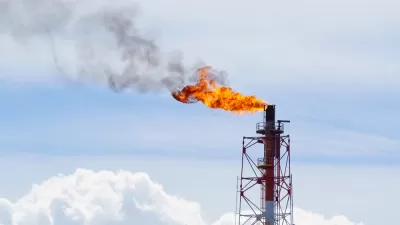President Barack Obama hopes to add to his "climate legacy" by having the EPA adopt the nation's first regulations to reduce methane emissions, the second most prevalent greenhouse gas emission after carbon dioxide, but far more powerful.
"The Obama administration announced an aggressive new plan Wednesday (Jan. 14) to combat global warming by targeting the methane emissions released through oil and gas production," writes Evan Halper of the Los Angeles Times.
The new regulations are only targeted (for now) at natural gas and petroleum activities which account for less than one third of U.S. methane emissions.

Credit: EPA
Note: All emission estimates from the Inventory of U.S. Greenhouse Gas Emissions and Sinks: 1990-2012. Enteric Fermentation refers to "methane released into the atmosphere from animal effluences" according to C2ES.
Methane emissions are currently controlled on a state level, allowing states to pursue regulation very differently. However, the energy industry is not happy with the idea of introducing federal regulations.
“Another layer of burdensome requirements could actually slow down industry progress to reduce methane emissions,” said American Petroleum Institute CEO Jack Gerard. [The Hill]
Methane, the main component of natural gas, accounts for "about 9% of all U.S. greenhouse gas emissions from human activities," according to the Environmental Protection Agency's webpage on methane emissions, which also indicates, "Pound for pound, the comparative impact of CH4 [chemical molecule for methane] on climate change is over 20 times greater than CO2 over a 100-year period."
Recent studies point to a higher number. Even the White House's press release and fact sheet on the new regulation states that it has “25 times the heat-trapping potential of carbon dioxide."
Prompting the regulation is the growth of the American energy sector, now the largest producer of natural gas in the world. Methane emissions have dropped 16 percent since 1990, but "emissions from the oil and gas sector are projected to rise more than 25 percent by 2025 without additional steps to lower them," according to the White House.
On the PBS NewsHour on Wednesday, Coral Davenport, energy and environment policy writer for The New York Times [see her piece], explains, "The president really wants to use these last two years of his term to build a legacy on climate change. He knows that he can’t move anything through Congress. He tried that in his first term, and it failed."
The LA Times' Harper adds, "The call for tighter controls on methane is part of Obama’s effort to use his executive authority under the Clean Air Act to confront global warming." In June, EPA release its plan to reduce emissions from existing power plants. The methane regulation, however, will be geared toward new wells, not existing ones.
Davenport writes that "the Interior Department is also expected to propose standards this spring that would reduce methane leaks from oil and gas wells on federal land."
A companion piece in the LA Times by environmental reporter Tony Barboza points to methane emissions that "are up to 61% higher than government estimates" in the Los Angeles basin. However, the source for the increased emissions is not known, though "scientists detected hot spots near major landfills."
Barboza points to a "study last year (that) found that natural gas drilling sites in Pennsylvania were releasing methane at rates 100 to 1,000 times greater than federal regulators had estimated."
FULL STORY: Obama administration moves to aggressively cut methane emissions

Planetizen Federal Action Tracker
A weekly monitor of how Trump’s orders and actions are impacting planners and planning in America.

Congressman Proposes Bill to Rename DC Metro “Trump Train”
The Make Autorail Great Again Act would withhold federal funding to the system until the Washington Metropolitan Area Transit Authority (WMATA), rebrands as the Washington Metropolitan Authority for Greater Access (WMAGA).

The Simple Legislative Tool Transforming Vacant Downtowns
In California, Michigan and Georgia, an easy win is bringing dollars — and delight — back to city centers.

The States Losing Rural Delivery Rooms at an Alarming Pace
In some states, as few as 9% of rural hospitals still deliver babies. As a result, rising pre-term births, no adequate pre-term care and harrowing close calls are a growing reality.

The Small South Asian Republic Going all in on EVs
Thanks to one simple policy change less than five years ago, 65% of new cars in this Himalayan country are now electric.

DC Backpedals on Bike Lane Protection, Swaps Barriers for Paint
Citing aesthetic concerns, the city is removing the concrete barriers and flexposts that once separated Arizona Avenue cyclists from motor vehicles.
Urban Design for Planners 1: Software Tools
This six-course series explores essential urban design concepts using open source software and equips planners with the tools they need to participate fully in the urban design process.
Planning for Universal Design
Learn the tools for implementing Universal Design in planning regulations.
Smith Gee Studio
City of Charlotte
City of Camden Redevelopment Agency
City of Astoria
Transportation Research & Education Center (TREC) at Portland State University
US High Speed Rail Association
City of Camden Redevelopment Agency
Municipality of Princeton (NJ)



























